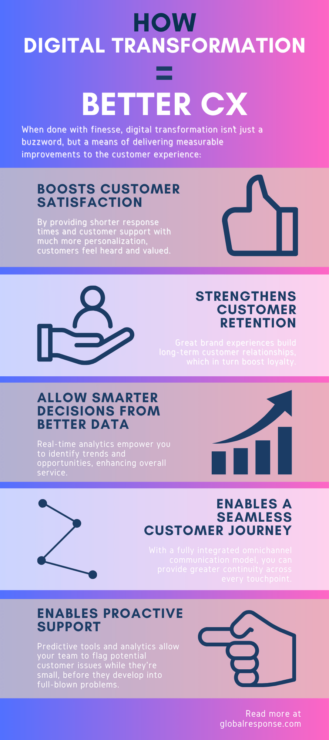Read Time: 9 minutes
Table of Contents
Introduction
The climate of customer service work is always changing, and the expectations of customers continue to evolve. Businesses have always competed to create the finest products and services, hoping to sell them at the most competitive prices. However, one competitive aspect of modern business that gets overlooked is who offers the best experience. If your business hopes to compete for the best customer experience in your niche, your best bet is digital transformation. When you fully embrace the best digital tools at your disposal and use them to their best potential within your use case, you won’t just keep up with trends — you’ll be thriving.
Key takeaways
- Digital transformation is essential for modern CX: Modern companies are able to provide faster, more personalized, and more consistent service by integrating modern digital tools into their workflow, such as AI solutions and CRM systems.
- Digital transformation requires both technological and cultural changes: Thought new technology and infrastructure are both important components of digital transformation, it’s also important for businesses to invest in training to ensure that their team is well-versed in using the new systems.
- Successful transformations require goals and phased integrations: By evaluating your current CX, setting clear goals, selecting the right tools for the job, and thoroughly training your team accordingly, you can successfully implement a digital transformation in gradual phases.

What is digital transformation?
Digital transformation is the practice of adopting and integrating digital technologies into every facet of your business.
This isn’t done in the name of technology for technology’s sake, but to enhance and enrich the customer experience in all areas that digital tools can offer a helping hand.
Digital transformation involves a shift in your organizational culture, taking a second look at how your business uses technology, people, and business processes, as well as looking deeply at how those aspects coalesce for excellent engagement and boosted performance.
See how digital transformation can empower your team to serve customers with greater speed, accuracy, and customization.
Why digital transformation in CX?
The best strategies and technologies can be instrumental for digital transformation, but the process is not without complexity.
Let’s dive into some of the pros and cons of digital transformation as it pertains to your customer experience.
Benefits
Digital transformation provides many advantages to your customer experience, the first being a major boost to customer satisfaction and retention.
With effective technological integration, interactions can become more convenient for customers, making it all the more likely that they stick around and form relationships with the brand for the long term.
Customization also becomes much more effective through the use of digital tools and the real-time data they allow you to leverage.
Each interaction can be tailored to the individual by taking their history, preferences, and buying behavior into account, allowing them to feel more valued and creating relevant and meaningful experiences that keep them coming back for more.
Another upside of digital transformation is the boost in operational efficiency.
Tools like automation, AI, and intelligent routing systems allow you and your team to more efficiently help customers, reducing overall wait times and improving the accuracy of responses.
By simplifying the more repetitive tasks with modern technology, you can allow your team the time and focus they need to prioritize your core competencies.
Finally, digital transformation provides you with the ability to make more accurate, data-backed decisions for your business, leveraging sentiment analysis to uncover trends and respond to customer needs proactively.
READ MORE: How AI is Transforming Contact Centers CX
Challenges
On the other hand, it should be stated that digital transformation for customer experience does come with some challenges.
A fairly common problem here is that of information silos.
Customer data can often be scattered over several different platforms, creating friction in the customer journey, where customers find themselves needing to repeat themselves whenever speaking to a new agent or over a new channel.
Further;
Legacy systems make things even more difficult, since outdated infrastructure and tech will often lack the speed or maneuverability required to support a fully modern customer experience.
Another obstacle to digital transformation is managing the organizational changes.
That’s why it’s important to remember that digital transformation is more than just an upgrade to your companies equipment, but ideally marks a shift in your company’s culture as it often takes a fair amount of work to train your team in using the new systems, redesign your workflows accordingly, and to finally get buy-in from everyone involved.
Finally, to maintain trust, it’s vital to keep data security and compliance at the top of mind during a digital transformation.
The flow of customer data is heavily regulated, so it’s important to take the laws and regulations around it seriously while upgrading your infrastructure to avoid weak points.
READ MORE: High-Touch CXM with Remote Teams: How to Humanize Outsourced Customer Support
Want to scale your business?
Global Response has a long track record of success in outsourcing customer service and call center operations. See what our team can do for you!
How digital transformation is changing customer experience
Digital transformation continues to change the ways that companies engage with customers, providing new technologies and channels to reach them, and giving rise to various new trends in how companies approach customer experience.
Technologies
New technologies, like artificial intelligence and machine learning, are playing a vital role in leveling up the customer experience.
AI and machine learning are quickly coming to the forefront of predictive customer support, empowering businesses to anticipate the needs of their customers and automate the common, more routine tasks in the workload with better accuracy.
Additionally;
Cloud-based contact center platforms provide scalability and flexibility to more businesses.
Using a cloud-based service model, businesses can serve their customers at any time, from anywhere, and do so while maintaining consistency and reliability.
Customer relationship management (CRM) systems and customer data platforms (CDPs) are also becoming a core feature of personalized engagement.
These tools work by unifying data across various touchpoints, using a centralized approach to assist brands with providing customer interactions that are much more timely and relevant.
Trends
Alongside each of these technologies, there are a handful of key trends currently influencing the ways in which companies approach CX.
Hyper-personalization has emerged as a priority, with many brands striving to use data in a way that tailors each interaction to the individual customer, even in real time.
That level of customization boosts the relevance of the experience to each customer, with the potential for fostering stronger relationships between customers and the brand.
Omnichannel engagement is also gaining a lot of steam, with many consumers expecting to receive seamless service across:
- voice
- chat
- social media
- and other channels
Companies with the foresight and infrastructure to unify these channels into a cohesive brand experience are more often better positioned to earn customer trust and loyalty.
Another trend transforming the CX landscape is the rise of proactive customer support through predictive analytics.
By understanding customer trends and behavioral patterns, it becomes much easier for businesses to recognize the early stages of a problem in development, or to know the seasonal periods when they are likely to, and use that data to reach out ahead of time.
READ MORE: The Hidden Power of an Omnichannel Contact Center
How digital transformation = Better CX
When done with finesse, digital transformation isn’t just a buzzword, but a means of delivering measurable improvements to the customer experience:
- Boosts customer satisfaction: By providing shorter response times and customer support with much more personalization, customers feel heard and valued.
- Strengthens customer retention: Great brand experiences build long-term customer relationships, which in turn boost loyalty.
- Allow smarter decisions from better data: Real-time analytics empower you to identify trends and opportunities, enhancing overall service.
- Enables a seamless customer journey: With a fully integrated omnichannel communication model, you can provide greater continuity across every touchpoint.
- Enables proactive support: Predictive tools and analytics allow your team to flag potential customer issues while they’re small, before they develop into full-blown problems.

Getting started with digital transformation
To embark on the journey of digital transformation, you’ll need to start with a clear idea of what your current customer experience looks like.
In practice, that means evaluating each and every touchpoint to work out where your customers are feeling friction or inconsistency in the process, and therefore feeling unsatisfied.
After establishing a baseline of your customer experience, the next step is to define your goals.
Consider exactly what success looks like to your organization in particular.
- Is it faster response times?
- More personalized customer interactions?
- Higher customer satisfaction scores?
When you finally have your goals in mind, you can select the ideal technology partners for you.
The tools you select should be tailored to your objectives, while also simplifying — not complicating — your operations.
As you implement these new systems, it’s just as important to invest in training your team.
Your team needs to have the knowledge and mastery necessary to leverage these tools in a way that establishes efficiency, effectiveness, and consistency of results.
Finally, rather than attempting to launch a full-scale transformation right at the start, try approaching the transformation in phases for more success.
Your first pilot initiatives can lay the groundwork while you track their performance, and from there, you can take advantage of the insights you gained in the early phases to inform larger rollouts.
How Global Response offers a great customer experience via digital transformation
At Global Response, we provide brands with a dedicated team of professional agents, fully outfitted with a digitally transformed infrastructure. We combine cutting-edge tech with years of CX expertise for a scalable, personal touch, a true extension of your brand.




